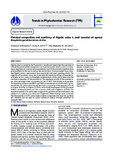Chemical composition and repellency of Nigella sativa L. seed essential oil against Anopheles gambiae sensu stricto

View/
Date
2020-04Author
Ndirangu, Ephantus G.
Opiyo, Sylvia A.
Ng'ang'a, M. W.
Metadata
Show full item recordAbstract
Malaria which is caused by the Plasmodium parasite and transmitted through bites of infected female Anopheles mosquitoes is an important public health concern in Africa. Insect repellents are commercially available but most of the synthetic repellents have adverse effects to the user as well as the environment. Previous studies have shown that Nigella sativa L. seed extracts have insecticidal and insect repelling activity. The objective of the present study was to evaluate the repellence efficacy of essential oil of Nigella sativa L. seeds on Anopheles gambiae sensu stricto and to determine the chemical composition of the essential oil. The repellence activity of the essential oil was dose-dependent and comparable to that of DEET (N,N-diethyl-m-toluamide). The repellence of the oil was 98.81 and 100% at concentrations of 0.01 and 0.1 g/mL, respectively. GC-MS analysis showed the major components of the essential oil to be p-cymene (34.67%), α-thujene (11.55%), trans-4-methoxythujane (5.81%), β-pinene (4.66%), methylcyclohexane (3.11%), α-pinene (2.82) and longifolene (2.55%). The repellence activity of N. sativa seed oil against An. gambiae can be attributed to the presence of α-pinene, p-cymene and longifolene. These findings have confirmed that the essential oil of N. sativa seeds contains compounds that repel An. gambiae and therefore can be used to control spread of malaria through prevention of mosquito bites.
Collections
- Journal Articles (PAS) [285]
